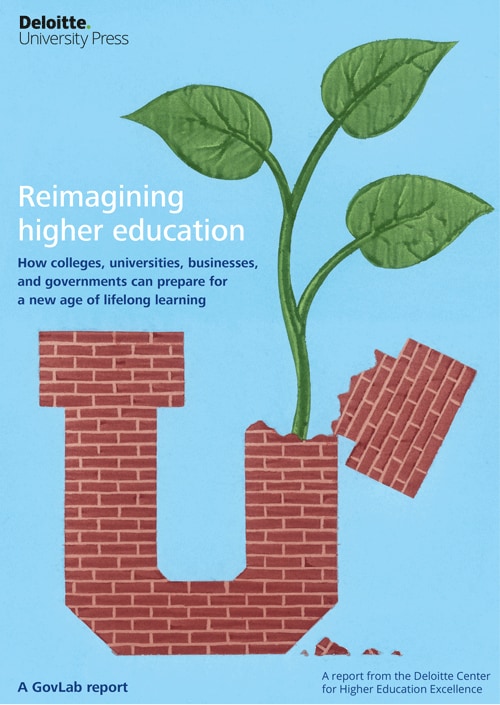
Higher education: New models for the future The State Policy Road Map: Solutions for the Journey Ahead
07 February 2018
College tuition has risen by 538 percent since 1985. States can influence the higher education landscape to better serve students and employers by evaluating how they can integrate the student experience in such areas as performance metrics, financial aid, and job placement.
What is the issue?
To maintain economic prosperity, a state needs well-educated citizens. State governments can help to influence the higher education landscape so that it better serves the needs of students, employers, and the population as a whole. Both directly through state institutions and indirectly through economic development initiatives, loans, and other programs, state leaders can have considerable influence on the higher education.
Higher education has changed considerably over the years, shaped by several macro-level trends:
Learn more
View the full collection
Subscribe to receive Public Sector content
View the table of contents and create a custom PDF, or download the full collection
Sign up for the webcast
- Workforce needs: According to ManpowerGroup, 46 percent of employers report being unable to find skilled workers to fill open jobs.1 To acquire skills that match employers’ needs, many students today are looking beyond traditional higher education to alternatives such as “nanodegrees” powered by massive open online courses (MOOCs), or short-term, immersive boot camps to provide just-in-time workplace skills.
- Pressure on institutions: The cost of college tuition has risen by 538 percent since 1985, compared with an increase of just 121 percent in the consumer price index during that period.2 According to one Pew Research Center survey, the millennial generation (defined by Pew as Americans aged 18 to 33) is dealing with higher levels of student loan debt, poverty, and unemployment, and lower levels of wealth and personal income, than the two preceding generations at the same age.3 Many colleges and universities are under pressure to reduce costs and to document the return on investment they provide.
Issue by the numbers: Higher education
- Today, 44 percent of college and university students are 24 years of age or older. Thirty percent attend class part-time, 26 percent work full-time while enrolled, and 28 percent take care of children or other dependents while pursuing their postsecondary studies.4
- On top of that, 52 percent of college and university students are the first in their families to seek higher education, 42 percent come from communities of color, and 18 percent are non-native English speakers.5
- The “sticker” price tag for a traditional four-year residential degree program has almost doubled in the last decade. The cost of tuition, fees, and room and board at out-of-state public universities now averages just over $35,000 per year; for private nonprofit universities, the average cost is more than $45,000 per year.6
- The cost of college tuition has risen by 538 percent since 1985, superseding household income gains (figure 5).7

- On average, states spent $1,448 (16 percent) less per student in 2017 than in 2008.8 Nearly every state has shifted the cost to students in the last 25 years (figure 6).9

- States spent about 10 percent of their general funds on higher education in fiscal year 2015, compared with 11.5 percent in the postrecession period (fiscal year 2009).10
How can state leadership tackle the issue?
Be thoughtful about coordinating assistance to nontraditional students
Financial aid programs that help with tuition and academic costs are as important as ever. But nontraditional students could also need other support, such as help paying for child care, transportation, and food. States should consider aligning public assistance programs with the needs of adults who attend schools and making public benefits easily accessible for those students who qualify.
Think more broadly about financial aid
In the future, students will consume education in many different ways—in the classroom, online, in full semesters, in short bursts, on the job, and through one-on-one mentoring, to name just a few. Most likely, these learning experiences will continue throughout a person’s career. Given that reality, state financial aid programs should consider making a wider variety of educational experiences eligible for aid.
Encourage state university systems to explore new options for instruction
Many institutions of higher learning today are experimenting with a broad range of new approaches, such as blended learning, adaptive learning, and competency-based education. New strategies for keeping nontraditional students on target to succeed are emerging as well. These include data-driven systems for detecting when a student needs extra help, tutoring and coaching programs to provide that help, and class schedules that make attending school easier for students who also hold down jobs, manage families, and rely on public transportation. State university systems should promote experimentation to find new solutions.
 Read more about how state university systems can explore different models of instruction in Reimagining higher education. |
Focus on the student
Every year across the United States, a significant number of students fail to complete their college degrees. “While it is true that retention programs abound on our campuses, most institutions have not taken student retention seriously,” noted Vincent Tinto, distinguished university professor emeritus in the School of Education at Syracuse University.11 Colleges and universities should adapt to the needs of a diverse, dynamic, and changing student population by providing flexible services and a greater sense of connection.
Steps can be taken to deploy new learning methods, develop comprehensive support services, streamline student-facing operations, and pursue strategic partnerships with employers and other entities. These efforts would help the state to train the workforce of tomorrow, reduce the time to graduation, and decrease the dropout rate.
 Read more about how state university systems can effectively support their students in Success by design. |
Strengthen the pathways from education to employment
Early college or dual enrollment programs can provide a bridge for high-school students who want to get a jump on their higher education, including students who need some extra help to prepare for college-level work. Public institutions can smooth students’ progress by agreeing on common course numbering systems and providing clear transfer pathways between two- and four-year colleges. And while students work toward their undergraduate degrees, co-op, internship, and apprenticeship programs can provide opportunities to earn money while honing skills that could make them attractive to employers in their chosen fields.
You don’t need to look too far for inspiration
Course Signals at Purdue
At Purdue University, some courses employ Course Signals, a software platform that uses data analytics to calculate and track student progress and provide early warnings to both students and faculty. Students receive notifications about how they are performing in a course as they progress through it. Faculty who receive this performance data are able to identify students who may need additional assistance to succeed and can target interventions to ensure that at-risk students stay on track. Students enrolled in Course Signals classes at Purdue have a 21 percent higher graduation rate than those enrolled in courses that don’t use the software.12
Low-cost computer science at Georgia Institute of Technology
Rather than trying to be all things to all people, some universities are beginning to carve out niches in the market for higher education, shedding unnecessary costs and better differentiating themselves from their peers.13 Georgia Institute of Technology, for example, has focused on providing the lowest-cost options in fields undergoing a rapid growth in demand. MOOC provider Udacity, in collaboration with AT&T, is powering Georgia Tech’s first accredited online master’s program in computer science with a price tag of just $7,000.14
Adaptive learning at Arizona State
To help new students who were not college-ready in mathematics, Arizona State University launched a math readiness program in the fall of 2011. This program uses adaptive learning technology to let students work through the program at their own pace, aided by an instructor.15 The program’s initial results showed improved outcomes, with fewer student dropouts, increased pass rates, and lower course completion times.16
Building bridges to college in Ohio
In the Appalachian region of Ohio, Zane State College and the Zanesville City Schools have created a program to help high-school seniors who have grade point averages of 3.0 or higher, but whose tests show them to be unprepared for college. The program includes career exploration, tutoring, mentoring, and a one-semester class on college success taught at the high school by college faculty. Participants also take college math and English courses for dual credit, and each student goes to the college to take a course specific to his or her major.17
© 2021. See Terms of Use for more information.







